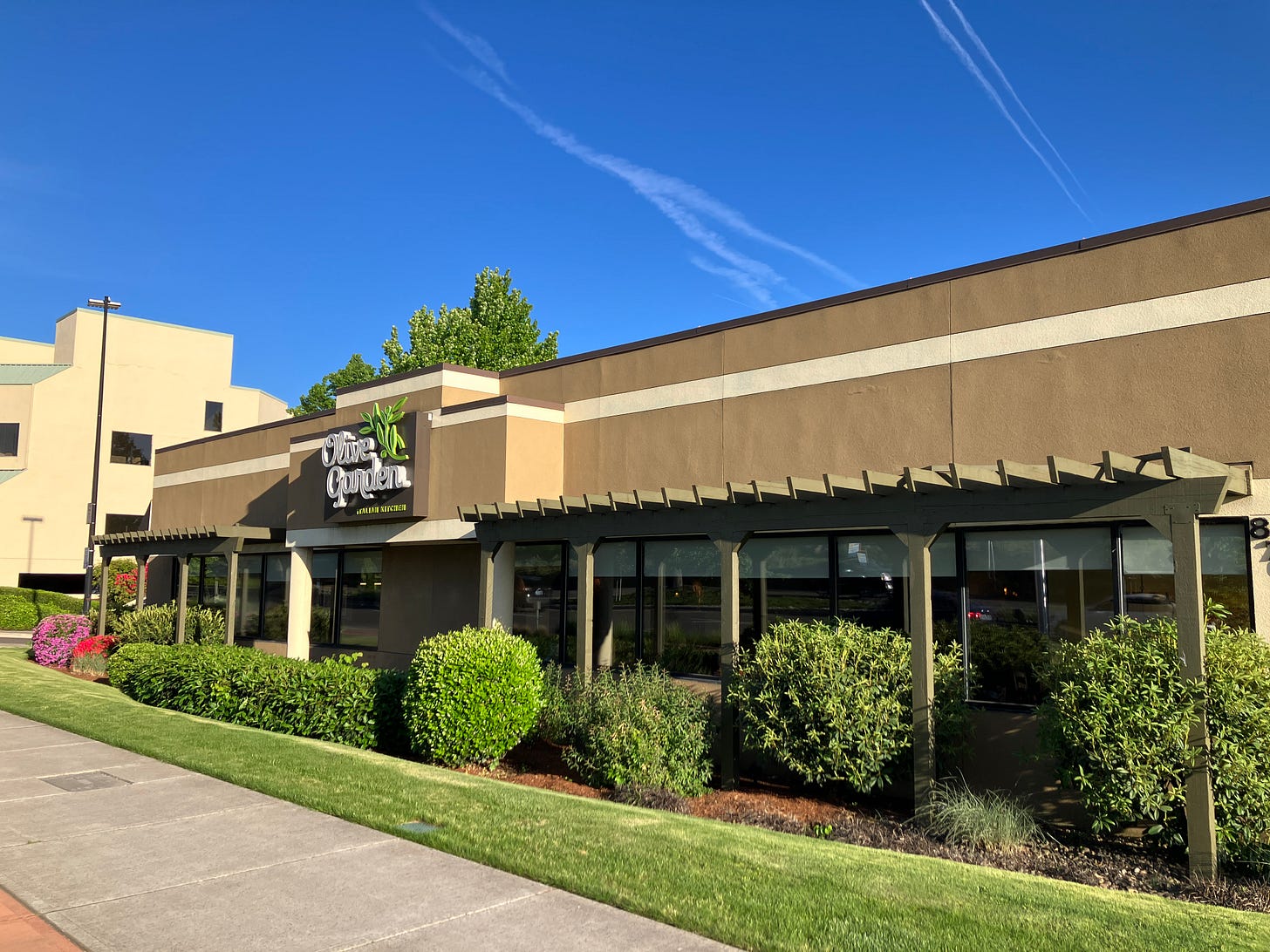Most people think of Portland as a hip place with fancy restaurants and front yard vegetable gardens but this is only a small portion of the city. Most of it is a mass of suburban sprawl. I was recently exploring a mall area on the edge of the city. It’s one of those places where parking lots spread out around boxy buildings near the crossing of an interstate and a state highway. The landscaping is lush and well kept. It had been some years since I had spent any time in such an area. One of my favorite things about these strange places is the restaurants. The stories I’ll recount will be a mixture of past and present so some aspects might be dated.
Red Robin. The Old Spaghetti Factory. Olive Garden. Applebee’s. T.G.I.Friday’s. And here’s one I hadn’t heard of before: Claim Jumper. Intrigued, I poked around on their website trying to find exactly what that name meant but all I learned is that they have expert chefs preparing USDA steaks. Nothing says “mouth-watering” like the acronym of a government inspection agency. According to the internet a claim jumper is someone that trespasses on someone else’s land in order to mine their resources. Basically it’s an old-timey version of stealing with a pick-axe. Okay. Bon appétit!
What intrigues me most about these commercial zones is the rituals. Families make it a special night out on the weekend. They put on particular clothes, something between business casual and suburban chic. It often involves grandparents. They walk in and tell the hostess, “Table for 6, please”. Then they are given a disc made of translucent plastic which will vibrate in approximately 20-30 minutes. Meanwhile, they find a bench to sit on in the waiting area. Among other things, they discuss the food they see the servers carrying while feeling somewhat classy about themselves coming to a “sit-down” restaurant.
I think back to my childhood where this ritual was the climax of a family visit. My family’s choice was always the Rolls Royce of the restaurant chains, Olive Garden. “When you’re here, you’re family”, complete with an old Brooklyn accent:
After we shuffle around negotiating where we’ll all sit in a booth, a basket of butter-soaked bread sticks shows up. Then comes a wooden bucket of salad with that giant scissor-spoon contraption to lift the crunchy iceberg lettuce and croutons onto our plates. The handles inevitably get smeared with dressing as it keeps falling into the bowl. A meal will be eaten before the appetizers arrive.
The server goes around the table to ask each person what combination of the same sauce and pasta everyone would like. Would you like lasagna (where we sandwich it all together) or spaghetti (where we dump it in a pile)? What slab of meat would you like dropped in the middle? Do you need any more breadsticks?
When the entrées arrive you get the real Italian feel, as if living in a villa outside of Napoli: fresh ground black pepper and grated “parmesan” are offered. “Say when” says the server. “When”. Smiles are exchanged. Short phrases and/or grunts are expressed around the table as each look down on the veritable boat of tomato sauce and pasta. “Wow, this is huge!”
Rare is the person that finishes this entire meal but I think that’s the point. This is the most fascinating part of the ritual. No one there genuinely believes you will consume all of this food - not the expert chefs, the management, the servers, and certainly not yourself. It’s as if your oversized, white, oval-shaped, pre-heated plate contains two meals blended together: one you will eat and one merely for display. The server knows she will soon return to the table and ask you this question: “Would you like that wrapped up?” You reply, “Yes, this was so good, please wrap it up”. This second meal is then scuttled off somewhere behind closed doors, to return again but this time with a bit less mise en place. It’s now transformed into a blob of tomato sauce and melted cheese smushed against the sides of a clear plastic clamshell, stacked with other clear plastic clamshells, in a large brown paper bag. Misers like myself will have insisted that the remaining bread sticks also be included in this package. In practice, it’s as if this whole ritual might say something like: “I know you aren’t going to eat all this now, but we wanted to show you today what you’ll be microwaving for dinner tomorrow”.
For a restaurant chain with 900 locations we can imagine that the costs of creating this excess food would add up considerably and yet this ritual endures. I can only conclude that it is a necessary, intractable part of this sit-down food experience. That somehow people can’t live without it. So there must be some kind of meaning to all this. What emotions does this evoke? A sense of material abundance? Feeling taken care of? A way to look forward to filling some kind of void the following day? How, exactly, has it become the norm to expect two meals when purchasing just one?
I free-associate to Roland Barthes’ idea of “the punctum” in his book on photography, Camera Lucida. The punctum is the detail in a photograph that unexpectedly pricks or punctures the viewer emotionally. I think of it as the most essential object in the scene that, when taken out, deflates the entire image. As strange as it is to mix the philosophy of art with suburban bouffe, it seems to me that the remainder of food on every plate at Olive Garden and restaurants like it is the punctum of the entire experience, the most essential point.
On this recent day as I was wandering through these suburban parking lots I saw a familiar sight: mostly overweight Americans, some in shirts they’d wear on a vacation to Florida, slowly ambling out of the restaurants with their iconic clear plastic clamshells full of this excess food. They had a slight glow as if carrying little trophies. While watching I listened to the whir of the nearby freeway sail over the occasional sound of an opening or closing car door. In the sky, a backdrop of warm colors as the evening light waned. It is this short parade from restaurant door to car door that is the consummation of the ritual, at least for now. It will be recalled the next day when the food is microwaved and eaten once more. At some point Olive Garden abandoned their slogan “When you’re here, you’re family” for “Go Olive Garden”, but checking their website today I see something even more direct than the original: “The comfort you crave”. I can’t help but wonder if that extra meal is more like a transitional object than an additional helping of fake Italian food, a piece of comfort to look forward to during a lonely evening in front of a television.
The last time I ate at an Olive Garden was in North Dakota in 2013. My girlfriend’s dad’s girlfriend had several Olive Garden gift cards. She pawned them off onto my girlfriend’s dad who pawned them off onto us as we prepared for our move across the country. We joked that we might just throw them out. In between blizzards in Minnesota and Montana, where I white-knuckled a Budget box truck as we literally skated through white-out conditions, we found an Olive Garden.
It had been years since going there with my family back home. Becoming an adult I had grown to care about the quality of food I put in my body and to become aware of how it made me feel. We lowered our expectations but not enough. It was one of the top 3 worst meals I had ever had. It’s etched into my memory like that time I saw a 400 lb woman pissing on the streets in San Francisco. The tomato sauce was so repulsive I literally couldn’t eat it. The place smelled nauseating. My girlfriend and I looked around in disbelief as everyone there seemed to be joyfully living in some kind of fantasy we had long ago extricated ourselves from and had forgotten existed at all. We did not get our leftovers “to go”. The ritual failed. ☹️
It would be easy to dig into Olive Garden (pun intended) and all the terrible restaurants like it. But I do wonder - was it this bad back in the day? Did my family believe this food was actually good? Have I changed or has the food version of planned obsolescence kicked in over the years, moving this cuisine from fake Italian to inedible? Regardless, it’s a strange thing to hold both nostalgia and visceral repulsion for the same place. I do still laugh at a restaurant that serves five courses that are all variations on bread (breadsticks, croutons, appetizers, pasta, cake). I also feel genuinely sad and angry at the sheer ugliness of the entire endeavor, this hollowed out soulless shell of Italian cuisine. Why, with more freedom than any other humans in history, do Americans create monstrous facsimiles of what was once beautiful, while at the same time idealizing and fetishizing trips to Europe to experience the “real thing”? How should we understand the schizophrenia of the American psyche?
My suburban adventure was a reminder of memories that now feel distant like a dream. It’s been so long since I’ve eaten in a restaurant with more than one location, serving a menu that was centrally mandated by a corporation. It’s been so long since my childhood where food was conceived of as a commodity made to appear the same across an entire nation like the culmination of a Soviet utopia, rather than a unique offering of a specific restaurant at a specific place and time. And it had been so long since I had seen food that was served with the deliberate expectation that not all of it would be eaten. Yet I also felt warmth at witnessing all this again, as if nostalgia doesn’t attach itself to what is good but simply what has happened.








